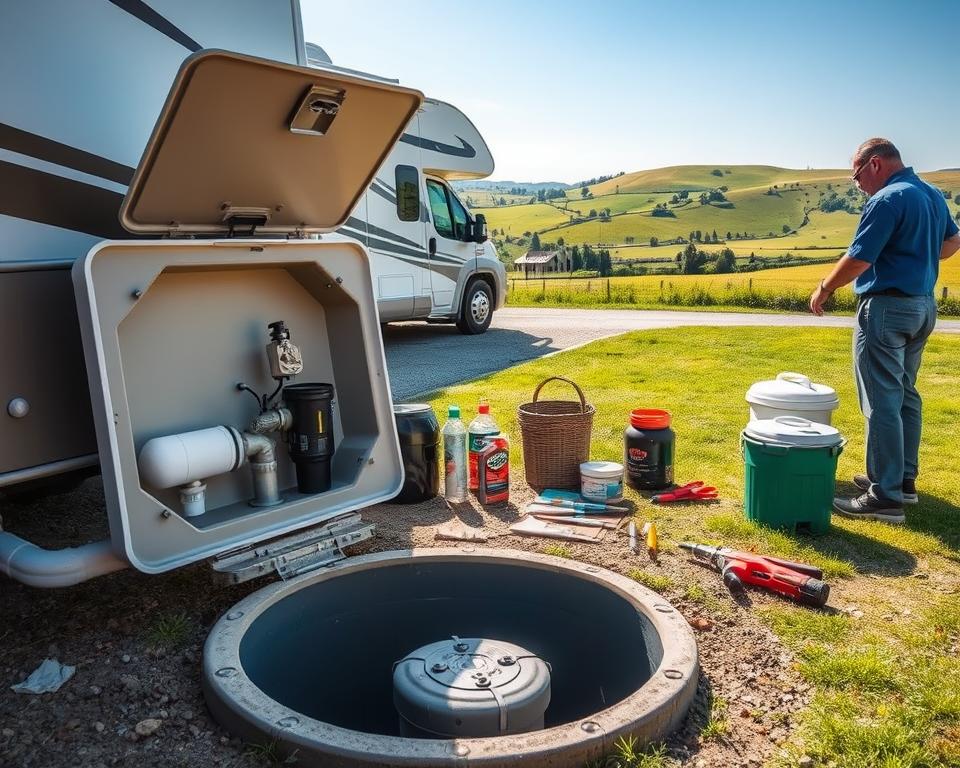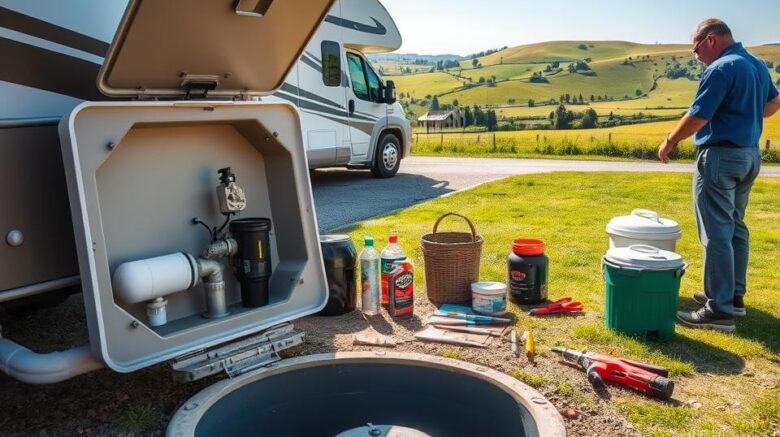Motorhome Water Tank plus Pump: Must-Read Manual
Have you ever questioned how seasoned RVers maintain perfect water flow while boondocking? It’s chiefly due to your RV water Tank & Pump. If you’re heading to the national-park circuit or a simple weekend retreat, mastering your RV’s water system is paramount. The following guide we unpack the fundamentals: the parts, servicing, and best practices for smooth travel. Knowing each component, from the linework to reservoir filling, secures water is always available during your journeys – RV black water tank pump.
Fundamental Findings
- Knowing the RV water system elevates your travel fun.
- The RV fresh-water Tank & Pump are crucial for a consistent water supply.
- Routine maintenance extends the lifespan of your RV plumbing.
- Knowing the right way to top up your Tank correctly can prevent future issues.
- Diagnosing your water Pump can spare you sudden problems.
Getting to Know RV Water Systems
RV water systems consist of two main parts: the potable-water setup and the wastewater mechanism. The fresh side boasts several key elements like the water Tank, Pump, and faucets, resembling household plumbing yet tailored for the mobile needs of living on the move.
Supplying potable water is crucial for the system’s efficiency. It protects the safety of all passengers. It’s vital to keep the RV plumbing in top shape through regular maintenance – including proper drainage to prevent leaks and other faults. Timely inspections let RV enthusiasts avoid water-related headaches during their journeys.

Why You Need the RV Water Tank
The RV water Tank is indispensable for a seamless journey. It stores the clean water needed for drinking, cooking, and cleaning. The volume of this container differs with each RV model, impacting how much water can be stored – and directly dictates how long you can travel before requiring a refill.
Maintaining the RV water Tank hygienic is essential. Regular cleaning prevents harmful contaminants, ensuring water remains safe for use. Neglecting maintenance can promote bacteria or algae growth, rendering the water hazardous.
Appreciating the RV water Tank’s role improves water management on the road. Diligent upkeep and timely refills ensure a stress-free experience. It’s crucial to have ample water for all travel needs, guaranteeing a trouble-free RV adventure.
How to Fill Your RV Water Tank
Filling your RV water Tank requires attentive action to ensure it’s done correctly. There are two main methods: gravity filling and city-pressure filling. Mastering these methods greatly enhances your RV conditions.
Gravity filling is simple. You just need a drink-safe water hose. Hook up this hose to a water source, then to the Tank’s opening, and let gravity do the rest. Always monitor the water level to prevent spills.
Using city pressure relies on a city water connection, which is faster delivery. You need to use a pressure regulator to control water flow. Connect the hose from the municipal source to your RV. This method ensures speedy and consistent supply to your Tank.
Either approach you use, adhere to these vital safety tips: Consistently monitor the fill when filling to prevent overflow, and draw only clean water to avoid health issues. Mastering these filling and safety techniques will make your RV trips even more enjoyable.
RV Water System: Parts in Focus
The RV Tank-and-Pump combo are integral to any RV’s plumbing system, providing a consistent and smooth water supply for all your needs. The RV water Pump’s main job is to push water from the reservoir, so clean water is always available. That’s critical for cooking, cleaning, and showering.
RV plumbing features different Pump types, each with unique benefits. Diaphragm pumps are favoured for their even water pressure, while centrifugal models are loved for mechanical simplicity and efficiency. It’s essential to weigh flow rate, noise, and installation ease when selecting your Pump.
To sum up, the RV water Tank and Pump are indispensable to your water system’s functioning. A dependable Pump guarantees strong pressure and smooth flow, boosting your overall travel experience.
Selecting the Right RV Pump
Choosing the appropriate RV water Pump is essential for your plumbing’s best performance. When shopping for a Pump, factoring in various points is important for a great camping experience. Ensuring it pairs with your RV’s water system is paramount.
Keep these crucial aspects in mind:
- Flow Rate: Select a Pump with a flow rate that matches your usage needs. A higher flow means faster reservoir refills.
- Pressure Ratings: Your RV’s various fixtures dictate the required pressure levels. Go with a Pump whose specs align with those needs for smooth operation.
- Noise Levels: Noise can be an issue with some Pumps. For a calm cabin, check models for their noise output.
Brands like SHURflo and VEVOR are high on the list for many RVers, providing stand-out perks. A careful assessment of these brands will assist your decision-making process.
Grasping these factors is not only important for the proper purchase but also arms DIY owners with practical know-how for upkeep and replacements.
Connecting to City Water for Your RV
Hooking your RV to city water allows for an uninterrupted supply of fresh water, moving you beyond just using your Tank. This guarantees a more convenient camping experience. Be sure to follow proper steps for a secure hookup.
First, identify the city water connection port on your RV. It’s commonly marked by a white or black connector, sometimes marked for ease. Grab a potable water hose rated for RVs; this type of hose keeps your water safe from contaminants.
It’s wise to install a pressure regulator before making the connection. This fitting protects your plumbing by taming the water pressure. With the regulator in place, link the hose from it to the water source.
Once connected, keep an eye on the water pressure. Aim for a steady, gentle flow to prevent hose damage. Check your hoses regularly for any wear or leaks and promptly replace parts as needed.
Following these steps for city hookup improves your camping convenience and aids in maintaining your RV’s condition.
Caring for Your RV Water Tank
Making sure your RV’s water Tank is properly maintained is essential for fresh, healthy water while travelling. A clean Tank helps prevent bacterial growth and contamination. First up, periodically sanitise the Tank: combine water with a bit of bleach for an effective residue-free clean.
It’s crucial to look for leaks and control Tank pressure. Regular checks can spot problems early, avoiding expensive fixes. A solid schedule preserves the water system in excellent health.
To streamline maintenance, use a checklist:
- Check water levels and quality often.
- Sanitise the Tank twice a year with a bleach solution.
- Inspect for seepage in the Tank.
- Monitor Tank pressure and Pump function.
- Flush the Tank to eliminate any sediment buildup.
RV Water Pump Diagnostics
RV water Pump glitches can be frustrating, disrupting travel plans unexpectedly. Encountering strange noises, experiencing low pressure, or suffering complete Pump failure are typical problems. Learning how to troubleshoot these issues can greatly enhance your trips.
If you hear odd sounds from your Pump is usually a problem. Start is to check for loose connections and secure them. When confronted with low water pressure, inspect hoses and fittings for leaks. Even a minuscule leak can greatly affect flow, prompt troubleshooting is essential.
If your Pump quits altogether, verify electrical connections. Start with examining the Pump’s fuse. Should the fuse is fine, look further for wear or damage.
A step-by-step routine isolates and rectifies water system issues. Regular maintenance and inspection guarantee easier journeys.
| Issue | Possible Cause | Suggested Solution |
|---|---|---|
| Strange Noises | Loose connections | Tighten fittings |
| Low Pressure | Leaky hoses/fittings | Find & seal leaks |
| Pump Failure | Electrical fault | Check fuse/wiring |
| No Water Flow | Blocked lines | Flush obstructions |
Best Practices for Smart RV Water Use
Camping in remote areas usually means limited water access. Efficient use in your RV is crucial. By embracing smart conservation tactics, you not only manage resources well but also boost camping satisfaction.
For maximum efficiency of water on the road, try these tips:
- Take quick showers – aim for under five minutes.
- Install water-saving fixtures like low-flow showerheads and faucets.
- Reuse grey water: dishwater can flush toilets or water plants.
- Monitor reservoir levels regularly to prevent overflow.
- Plan water stops in advance: know filling stations along your route.
Conclusion
Grasping the intricacies of your RV water systems is central to a successful travel adventure. The Tank and Pump remain at the centre of this, needing consistent upkeep. By maintaining these systems, you guarantee a dependable supply and dodge potential snags.
Consistent troubleshooting and checks limit stress and save time. Being proactive about upkeep is crucial, especially when you’re miles away from help. Proper care enables you to maximise water use, boosting comfort for everyone.
On your next outing, leverage this guide to tame your RV’s water systems. Smart decisions about plumbing and equipment equip you to embrace the freedom of the road. Enjoy joyous and memorable travels ahead!
